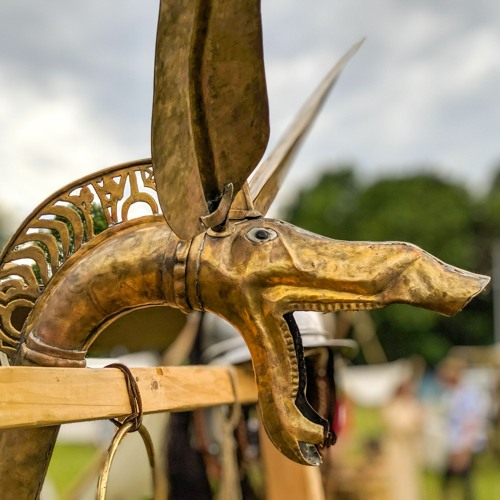In 2004, archaeologists excavating the Gallic and Gallo-Roman sancturary of Tintignac in the south central French region of Corrèze discovered a deposit of metal parts that had been ritually destroyed and buried in the first or second century B.C. Similar discoveries have been made at other Gaulish sites, but this find was unusual for its size – more than 500 artifacts or fragments thereof were packed into a pit just over four feet square and one foot deep — and for its contents. Among the deliberately hammered and bent objects were weapons like shields, swords and nine helmets, eight bronze and one iron. One of the bronze helmets was of a design never seen before or since: a swan whose gracefully curved neck forms a frontal horn then bends back to the neck guard which is shaped like the tail of the bird.

As hard as that is to beat, the remains of seven carnyces were also found. A Carnyx is a vertical trumpet the Gauls and other Celtic peoples across Europe used for ceremonial and military purposes. Their height — they could be six feet high — ensured the sound would carry above the battle fray, rally the troops and terrify the enemy. They were seen as symbols of Gaul as early as the Gallic invasion of Greece in the late 3rd century B.C. We know of them from contemporary descriptions (Diodorus Siculus comments on their “harsh sound, appropriate to the tumult of war” in Book 5, Chapter 30 of his Histories, images on coins (carnyces make several appearances on coins as symbols of Caesar’s victories in the Gallic Wars) and on the Gundestrup cauldron, discovered in a peat bog in Denmark in 1891. For the Asterix fans among you, you should recognize the carnyx as one of the instruments wielded by Cacofonix the bard and by the Gauls and their allies in their skirmishes against the benighted Romans.

Here’s a wonderful video of the find. You see the archaeologists slowly revealing one animal head after another, exclaiming in wonder as they find a large spearhead and the beautiful swan helmet which appears to have been unearthed basically intact. It brings a little tear to my eye, I won’t lie.
[youtube=http://www.youtube.com/watch?v=479eSll671w&w=430]
Before the Tintignac discovery, the remains of only five actual carnyces had been found. The most complete among them was the Deskford carnyx found in Scotland in 1816, and it’s just a head, albeit a remarkably complex multi-part stylized boar head with an articulated jaw. Finding seven in one place, in their proper archaeological context and excavated with modern procedures was an incredible windfall.

A careful examination of the fragments revealed an even greater windfall: 40 of the pieces belonged to a single carnyx topped with the stylized head of a boar with powerful canine tusks and massive ears. Archaeologists were then able to piece the fragments together and reconstruct the first complete carnyx ever found. It is an inch short of six feet long and only one part of one segment of the tube is missing.
The complete carnyx has been part of several museum exhibits over the past few years, often in company with the swan helmet and some of the other Tintignac carnyx heads. Right now until March 3rd, 2012, it’s at the Science Pavilion in Montbéliard on the eastern border with Switzerland.
Meanwhile, archaeologists, instrument makers and acoustics experts have been working together this year to create an exact replica of the carnyx to study its sound and how it was played. Replicas of carnyces have been made before. They’re quite popular, in fact, in re-enactment circles, and trombonist John Kenny has been giving concerts on his replica of the Deskford carnyx since the early 1990s. They only had the head to work with, though. The Tintignac carnyx provides a unique opportunity to examine almost the entire length of the instrument.
Joël Gilbert, a brass instruments specialist at the acoustic laboratory of Maine-CNRS University in Le Mans, headed the research team. They found that which notes could be played on the carnyx depended on the resonance frequency.
If the musician had the base note he could easily produce others (mainly octaves, fifths and thirds), by modulating air flow and lip tension.
The carnyx has a fairly low base note because of its length but researchers found that the resonance frequencies obtained with the copy of the carnyx were far from harmonic. According to Gilbert, when he and his colleagues looked into this they suddenly had an idea. “The carnyx is not a primitive instrument and it was known for being very powerful. We therefore worked on the hypothesis that our copy was incomplete,” he said.
[Lead Tintignac archaeologist Christophe] Maniquet believes that is quite plausible, especially since no one is really sure how the mouthpiece connects to the tube. The acoustics experts have pursued their research by doing simulations with a mathematical model, this time adding an additional part to a virtual carnyx. They tested two lengths, 10cm and 20cm, which produced a lower sound and altered the resonance harmony.
The simulations showed that the optimum length was achieved by adding a 10cm part, which could match an item in the catalogue of finds from the Tintignac site. Maniquet is now planning to build a second prototype instrument to include the additional 10cm. “That should make this carnyx more powerful and easier to play,” said Gilbert, confident that his calculations are correct.
I can’t wait to hear it. Until then, we’ll have to make do with John Kenny playing his reconstruction of the Deskford carnyx. The variety of notes it can produce is amazing. I can see how it would have been damned intimidating on the battlefield. It sounds like a combination trumpet, foghorn and didgeridoo.
[youtube=http://www.youtube.com/watch?v=hVAWwWi0DbE&w=430]